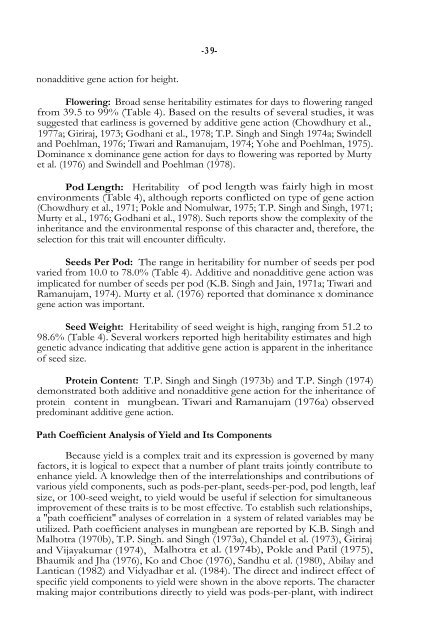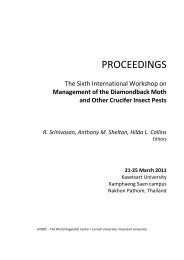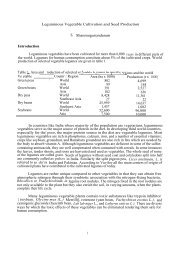MUNGBEAN VARIETAL IMPROVEMENT S. Shanmugasundaram
MUNGBEAN VARIETAL IMPROVEMENT S. Shanmugasundaram
MUNGBEAN VARIETAL IMPROVEMENT S. Shanmugasundaram
You also want an ePaper? Increase the reach of your titles
YUMPU automatically turns print PDFs into web optimized ePapers that Google loves.
-3 9-<br />
nonadditive gene action for height.<br />
Flowering: Broad sense heritability estimates for days to flowering ranged<br />
from 39.5 to 99% (Table 4). Based on the results of several studies, it was<br />
suggested that earliness is governed by additive gene action (Chowdhury et al.,<br />
1977a; Giriraj, 1973; Godhani et al., 1978; T.P. Singh and Singh 1974a; Swindell<br />
and Poehlman, 1976; Tiwari and Ramanujam, 1974; Yohe and Poehlman, 1975).<br />
Dominance x dominance gene action for days to flowering was reported by Murty<br />
et al. (1976) and Swindell and Poehlman (1978).<br />
Pod Length: Heritability of pod length was fairly high in most<br />
environments (Table 4), although reports conflicted on type of gene action<br />
(Chowdhury et al., 1971; Pokle and Nomulwar, 1975; T.P. Singh and Singh, 1971;<br />
Murty et al., 1976; Godhani et al., 1978). Such reports show the complexity of the<br />
inheritance and the environmental response of this character and, therefore, the<br />
selection for this trait will encounter difficulty.<br />
Seeds Per Pod: The range in heritability for number of seeds per pod<br />
varied from 10.0 to 78.0% (Table 4). Additive and nonadditive gene action was<br />
implicated for number of seeds per pod (K.B. Singh and Jain, 1971a; Tiwari and<br />
Ramanujam, 1974). Murty et al. (1976) reported that dominance x dominance<br />
gene action was important.<br />
Seed Weight: Heritability of seed weight is high, ranging from 51.2 to<br />
98.6% (Table 4). Several workers reported high heritability estimates and high<br />
genetic advance indicating that additive gene action is apparent in the inheritance<br />
of seed size.<br />
Protein Content: T.P. Singh and Singh (1973b) and T.P. Singh (1974)<br />
demonstrated both additive and nonadditive gene action for the inheritance of<br />
protein content in mungbean. Tiwari and Ramanujam (1976a) observed<br />
predominant additive gene action.<br />
Path Coefficient Analysis of Yield and Its Components<br />
Because yield is a complex trait and its expression is governed by many<br />
factors, it is logical to expect that a number of plant traits jointly contribute to<br />
enhance yield. A knowledge then of the interrelationships and contributions of<br />
various yield components, such as pods-per-plant, seeds-per-pod, pod length, leaf<br />
size, or 100-seed weight, to yield would be useful if selection for simultaneous<br />
improvement of these traits is to be most effective. To establish such relationships,<br />
a "path coefficient" analyses of correlation in a system of related variables may be<br />
utilized. Path coefficient analyses in mungbean are reported by K.B. Singh and<br />
Malhotra (1970b), T.P. Singh. and Singh (1973a), Chandel et al. (1973), Giriraj<br />
and Vijayakumar (1974), Malhotra et al. (1974b), Pokle and Patil (1975),<br />
Bhaumik and Jha (1976), Ko and Choe (1976), Sandhu et al. (1980), Abilay and<br />
Lantican (1982) and Vidyadhar et al. (1984). The direct and indirect effect of<br />
specific yield components to yield were shown in the above reports. The character<br />
making major contributions directly to yield was pods-per-plant, with indirect

















